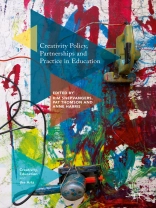This book examines the gaps in creativity education across the education lifespan and the resulting implications for creative education and economic policy. Building on cutting-edge international research, the editors and contributors explore innovations in interdisciplinary creativities, including STEM agendas and definitions, science and creativity and organisational creativity amongst other subjects. Central to the volume is the idea that good creative educational practice and policy advancement needs to reimagine individual contribution and possibilities, whilst resisting standardization: it is inherently risky, not risk-averse. Prioritising creative partnerships, zones of contact, practice encounters and creative ecologies signal new modes of participatory engagement. Unfortunately, while primary schools continue to construct environments conducive to this kind of ‘slow education’, secondary schools and education policy persistently do not. This book argues, from diverse viewpoints and methodological perspectives, that 21st-century creativity education must find a way to advance in a more integrated and less siloed manner in order to respond to pedagogical innovation, economic imperatives and creative possibilities, and adequately prepare students for creative practice, workplaces and publics. This innovative volume will appeal to students and scholars of creative practice as well as policy makers and practitioners.
Cuprins
Chapter 1. Evolving ecologies: Creative policy, partnerships and practice in education; Anne Harris, Pat Thomson and Kim Snepvangers.- SECTION I. POLICY.- Chapter 2. What did Creative Partnerships achieve? A review of the Creative Partnerships (CP) research archive; Patricia Thomson, Rebecca Coles and Maddy Hallewell.- Chapter 3. Transforming creative classroom contradictions through activity theory analysis; Victoria Kinsella.- Chapter 4. Creative Agency / creative ecologies; Anne M. Harris.- Chapter 5. Value-adding in higher education: Complementary contexts for learning creativities; Jonathan Purdy, Vinesh Chandra and Kelli Mc Graw.- SECTION II. PARTNERSHIPS.- Chapter 6. Creative partnerships: Exploring encounters in the contact zone; Donna Mathewson Mitchell.- Chapter 7. Creative industry encounters: Digital ecologies in art, design and media; Kim Snepvangers.- Chapter 8. Organisational change for creativity in education; Leon de Bruin.- Chapter 9. Creative ecologies in education: teaching relationships within sustained school-based artist-in-residence projects; Christine Hatton and Mary Mooney.- SECTION III. PRACTICE.- Chapter 10. The antecedents and outcomes of creative cognition; Sarah Asquith, Xu Wang and Anna Abraham.- Chapter 11. Assessing Creativity: Four Critical Issues; Rachel Jacobs.- Chapter 12. Tearing it down: Using problematisation to encourage artistic creativity; Shelley Hannigan and Katherine Barrand.- Chapter 13. From Wise Humanising Creativity to (posthumanising) creativity; Kerry Chappell.- Chapter 14. An ecology of care: Relationships and responsibility through the constitutive and creative acts of oral history theatre making in local communities shouldering global crises; Kathleen Gallagher, Nancy Cardwell and Dirk Rodricks.- Chapter 15. Flexibility, constraints and creativity – cultivating creativity in teacher education; Susan Davis.- Chapter 16. Propositions for policy, partnership and practice in educational creative futures; Kim Snepvangers, Anne Harris and Pat Thomson.
Despre autor
Kim Snepvangers is Director: Professional Experience and Engagement Projects and a UNSW Teaching Fellow at UNSW Sydney: Art & Design, Australia. Her research interweaves creative and professional industry contexts and engages visualisation with creative ecologies, critically reflective frameworks and embodied pedagogies.
Pat Thomson is Convenor of the Centre for Research in Arts, Creativity and Literacy (CRACL) at the University of Nottingham, UK. She is known for her interdisciplinary engagement with questions of creative and socially just learning and change.
Anne Harris is Associate Professor and Vice Chancellor’s Principal Research Fellow at RMIT University, Australia. She researches in the areas of creativity, culture, diversity and digital media.












